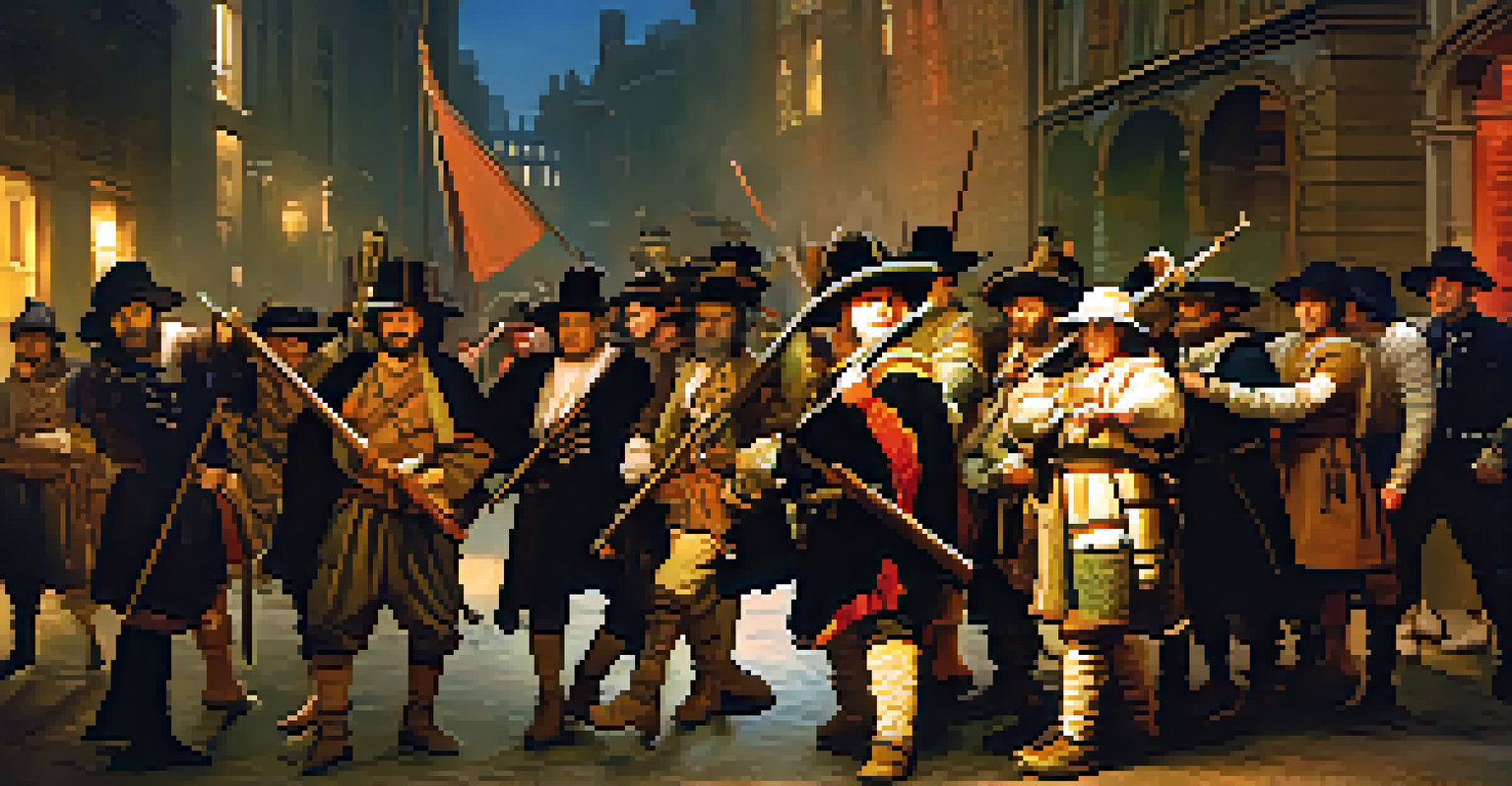The Role of Famous Paintings in Modern Cinema Narratives

The Intersection of Art and Film: A Timeless Relationship
Art and cinema have shared a deep-rooted connection since the dawn of filmmaking. Famous paintings often serve as visual touchstones, enriching narratives and providing layers of meaning. By referencing iconic artworks, filmmakers can evoke emotions, set moods, and even foreshadow events in their stories.
Art is the most beautiful of all lies.
For instance, in 'The Da Vinci Code', the inclusion of Leonardo da Vinci's masterpieces adds a sense of intrigue and complexity to the plot. Viewers familiar with these paintings are invited to make connections, deepening their engagement with the film. This relationship highlights how visual art can transcend its medium to enhance storytelling.
As modern cinema continues to evolve, the influence of famous paintings remains vital. Filmmakers are constantly inspired by the themes, emotions, and stories encapsulated in these artworks, demonstrating that art is not just a backdrop but a character in its own right.
Symbolism in Film: The Power of Visual References
Symbolism plays a crucial role in both painting and film, allowing creators to convey complex ideas without words. A famous painting can symbolize broader themes, such as love, loss, or betrayal, which filmmakers can then weave into their narratives. This technique enriches the viewer's experience by inviting interpretation and reflection.

Take, for example, the use of Edvard Munch's 'The Scream' in various films. Its representation of existential dread resonates with characters facing their own crises, adding depth to their journeys. By integrating such potent symbols, directors can create a visual language that speaks volumes.
Art Enhances Film Narratives
Famous paintings enrich cinema by adding layers of meaning and emotional depth to storytelling.
Moreover, these visual references often serve as conversation starters, prompting audiences to explore the connections between art and life. The blending of painting and film not only enhances storytelling but also fosters a deeper appreciation for both art forms.
Emotional Resonance: Art as a Catalyst for Feelings
Famous paintings evoke strong emotions, and filmmakers harness this power to enhance their narratives. The emotional weight of a piece can set the tone for a scene, making it more impactful. Filmmakers use this to their advantage, creating moments that resonate with the audience on a deeper level.
Cinema is a matter of what's in the frame and what's out of it.
Consider the film 'Girl with a Pearl Earring,' inspired by Johannes Vermeer’s painting. The artwork's subtle beauty is mirrored in the film's storytelling, drawing viewers into the characters' emotional landscapes. The painting becomes a visual anchor, heightening the stakes and enriching the viewer's connection to the narrative.
By thoughtfully integrating famous paintings, filmmakers can tap into a wellspring of emotions, making their stories more relatable and memorable. This emotional resonance is a testament to the enduring power of art in shaping human experiences.
Cultural Commentary: Art Reflecting Society in Cinema
Famous paintings often encapsulate the social and cultural contexts of their time, and filmmakers can leverage this to comment on contemporary issues. By drawing parallels between historical art and modern narratives, movies can spark conversations about societal values, struggles, and progress.
For example, movies like 'The Hunger Games' have used references to classical art to critique modern society's obsession with spectacle and power. By placing iconic artworks within their narratives, filmmakers invite audiences to reflect on the implications of these themes. This commentary adds a layer of depth that resonates beyond the screen.
Symbolism Deepens Viewer Experience
Visual references in film, such as iconic artworks, allow for complex themes and foster audience reflection.
This blending of art and cinema allows for a rich exploration of cultural dialogues, showing how art can serve as both a mirror and a lens through which to view society. As filmmakers continue to engage with famous paintings, they contribute to an ongoing conversation about the human experience.
The Aesthetic Appeal: Visuals that Captivate Audiences
The aesthetic quality of famous paintings can elevate a film's visual storytelling. Filmmakers often borrow color palettes, composition styles, and lighting techniques from renowned artworks to create visually stunning scenes. This approach not only captivates but also enhances the narrative's emotional depth.
For instance, films like 'The Great Gatsby' intentionally echo the vibrant colors and opulent style of art deco paintings, immersing viewers in the era's atmosphere. By channeling these aesthetics, filmmakers create a unique visual experience that resonates with audiences on multiple levels.
Ultimately, the integration of famous paintings into cinema is a marriage of artistry and storytelling. This synergy results in films that are not only beautiful but also rich with meaning, drawing viewers into a world where art and narrative intertwine.
Reimagining Classics: Modern Takes on Iconic Art
Modern cinema often reinterprets famous paintings, presenting them in a new light or context. This practice breathes fresh life into classic art, allowing filmmakers to explore contemporary themes while paying homage to the originals. Such reinterpretations can reignite interest in the artworks themselves.
Take 'The Night Watch' by Rembrandt, which has inspired various films that explore themes of duty and sacrifice. By placing the painting's characters in modern scenarios, filmmakers can draw parallels that resonate with today’s audiences, making the art relevant to current issues.
Cinema as an Educational Tool
Integrating art into films provides an engaging way for audiences to learn about art history and its significance.
These modern takes not only pay tribute to the masters but also encourage viewers to engage with the art in new ways. As cinema continues to evolve, the reinterpretation of iconic pieces serves as a bridge between the past and present, fostering a deeper appreciation for both.
Educational Value: Learning Through Film and Art
Integrating famous paintings into film can serve an educational purpose, introducing audiences to art history in an engaging manner. Through storytelling, viewers can learn about the context, techniques, and significance of various artworks without feeling overwhelmed by traditional art education methods.
Films like 'The Monuments Men' not only entertain but also educate viewers about the importance of preserving art during times of conflict. By showcasing famous paintings and their histories, filmmakers can spark interest in art appreciation among a broader audience.

This educational aspect highlights the role of cinema as a tool for cultural enrichment. By blending entertainment with learning, filmmakers can inspire future generations to explore the world of art and its impact on society.